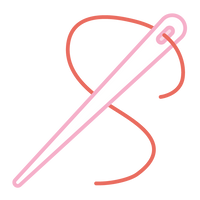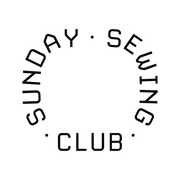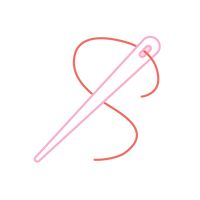Sewing terminology
A handy glossary of sewing words you’ll come across in our patterns (and beyond). Whether you’re just getting started or you’ve been sewing for years, it’s always nice to have a reference nearby.
A – C
Awl – A small pointed tool used to poke holes in fabric or leather.
Backstitch – At the start and end of a seam, sew a few stitches forward, sew back over them, then continue sewing as normal. This stops the stitches from unraveling.
Baste / Basting – Long, temporary stitches, normally done by hand, to hold fabric in place before sewing it properly. Usually removed later.
Bias – The 45-degree angle across the grain of woven fabric. It has the most stretch.
Bias tape – A narrow strip of fabric cut on the bias and used to finish edges neatly.
Bobbin – The little spool that sits underneath your needle and holds the bottom thread.
Box pleat – A pleat that folds fabric in opposite directions to create volume.
Buttonhole – A small reinforced slit for a button to pass through.
Casing – A fabric tunnel to feed elastic or drawstring through.
Clipping – Making small triangle cuts into seam allowances, especially around curves, so they lie flat.
Coverstitch – A stretchy stitch with parallel rows on top and loops underneath, perfect for knit hems. Usually done on a special coverstitch machine, not a regular sewing machine.
D – F
Dart – A sewn-in triangle that helps shape the fabric around curves (like busts or waists).
Drape – How a fabric hangs or flows. Some fabrics drape softly, others are more structured.
Ease – A little extra room added into the garment so you can move comfortably. It can also be used in the context of carefully aligning two curved edges of fabric, such as a shoulder and armhole, so there is no puckering.
Edgestitch – A straight stitch sewn really close to the edge for a crisp finish.
Facing – A piece of fabric sewn on the inside to finish and support edges, like necklines.
Feed dogs – The metal teeth under your needle plate that pull the fabric through.
Finish (a seam) – Overlocking/serging or zig-zag stitching a raw fabric edge to stop it from fraying.
French seam – A clean seam that hides raw edges by sewing wrong sides, trimming, then sewing right sides together. A good option for finishing seams if you don't have an overlocker/serger, or if you're using with a fabric that doesn't work well with an overlocker/serger (e.g. Chiffon).
G – I
Gathering – A technique to bunch up fabric, usually by sewing long stitches and pulling the thread.
Grainline – The direction of threads in fabric. The lengthwise grainline runs parallel to the selvedge and the crosswise grainline runs perpendicular to the selvedge. Both drape differently – the lengthwise grain has more drape, and the crosswise grain is sturdier. Patterns usually have an arrow showing how to align pieces with the lengthwise grainline.
Gusset – An extra piece of fabric added on top of another to give extra room and reinforce the garment, making those spots stronger and more comfortable (e.g. underwear).
Hem – The finished bottom edge of a garment.
Hand wheel – The knob on your sewing machine that manually raises or lowers the needle.
Hook and eye – A small but strong fastener made of two parts: a hook (a little metal clasp) and an eye (a loop or bar). Commonly used on trousers, dresses, and bras.
Interfacing – A layer added inside collars, waistbands, and cuffs to give extra stiffness and support, helping these parts keep their shape. It can be sewn in or ironed on.
Invisible zip – A zipper designed to be hidden inside a seam, so you can’t see the teeth or stitching from the outside. It creates a clean, polished look, perfect for dresses and skirts.
J – L
Jersey – A type of stretchy knit fabric. Comfy, casual, and great for tees.
Knit fabric – Fabric made by looping threads together, rather than weaving them over and under. This construction gives it natural stretch. Knit fabrics don’t usually fray, and they often drape softly.
Lining – The inner layer of a garment or accessory that helps it look polished.
Lockstitch – The most common type of stitch made by standard sewing machines, where the top thread and the bobbin thread lock together between the fabric layers. This creates a strong, secure stitch that doesn’t unravel easily. The straight stitch you see on your fabric is usually a lockstitch.
M – O
Markings – Symbols on the pattern (or fabric) to guide you – like darts, notches, and grainlines.
Notch – A small mark on the edge of a pattern that helps you match pieces accurately when sewing. Notches can look like short lines or triangles, and are often placed at seams, sleeve caps, pleats, and darts. You can cut them outward as little triangles or mark/snip inward slightly – just don’t cut past the seam allowance.
Nap – The direction of the surface texture, like velvet or corduroy. It needs to be cut consistently.
Overlocker / Serger – A specialised sewing machine that trims the fabric edge and finishes it with an overlock stitch. It’s an easy way to stop seams from fraying. You can also turn off the cutting blade if you just want to neaten the edge without trimming.
P – R
Pattern – The paper template you use to cut out your fabric pieces.
Patch pocket – A pocket sewn directly onto the outside of a garment or accessory.
Pivot – When you keep the needle down and rotate the fabric to change direction while sewing.
Pleat – A fold in fabric that adds shape and volume. There are different types categorised by how the pleat is folded, including: Knife pleat, box pleat and inverted pleat.
Press – Using your iron to flatten or shape your fabric.
Presser foot – The part of the sewing machine that presses down on your fabric while you sew. You can swap it out depending on what you’re sewing – like using a zipper foot, buttonhole foot, or walking foot.
Quilting – Stitching multiple layers of fabric together, often with padding in between.
Raw edge – The cut edge of the fabric that hasn’t been finished yet.
Reinforce – Extra stitching to strengthen certain areas (like corners or stress points).
Right side – The front or outer side of your fabric. The bit you want showing.
S – U
Seam – Where two pieces of fabric are sewn together.
Seam allowance – The space between the stitching line and the raw edge – usually 1cm (3/8")
Selvedge – The finished, tightly woven edge along the sides of fabric.
Staystitching – A row of straight stitches sewn just inside the seam allowance on curved or bias edges. It helps prevent the fabric from stretching while you sew the pieces together. This is especially useful for necklines and armholes.
Stitch length – How long each individual stitch is.
Straight Stitch – The basic stitch your sewing machine makes in a straight line. It’s used for most sewing tasks.
Slipstitch – A very neat hand stitch used to close openings like hems, linings, or seams where you don’t want any visible stitching on the outside. You sew by catching just a tiny bit of fabric from the folded edge on one side and then a small stitch from the fabric underneath. This makes the thread almost invisible.
Topstitching – A line of stitching on the outside of a garment for decoration or strength.
Tension – How tight or loose your thread is.
Trim – To cut away excess fabric or thread.
Toile – A test garment made to check the size and style before cutting your final fabric.
Understitching – A line of stitching that keeps facings or linings from rolling to the outside.
Unpicker / Seam Ripper – A tool used to undo stitches.
V – Z
Vent – A slit in the garment to help with movement – often in skirts, jackets or sleeves.
View – A variation of a sewing pattern. Think: same base, different neckline or sleeve.
Warp – The lengthwise threads in woven fabric that run parallel to the selvedge. They are usually stronger and more tightly stretched during weaving.
Weft – The crosswise threads that run perpendicular to the warp. They weave over and under the warp threads to create the fabric.
Woven fabric – Fabric made from threads criss-crossed in a grid. Doesn’t stretch much.
Wrong side – The back or inside of your fabric. Usually where seams and interfacing live.
Yoke – A shaped section, often at the top of a shirt or skirt, to help with fit or design.



